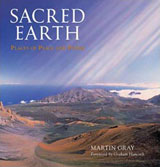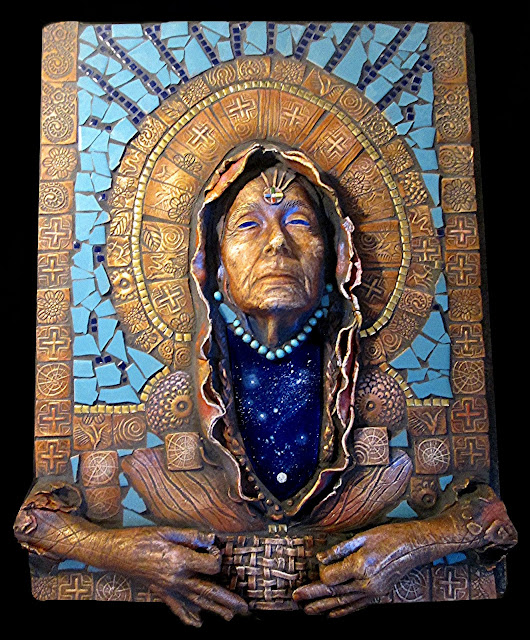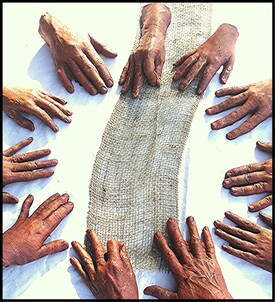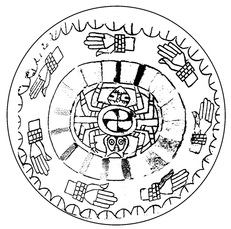I seem to be getting a "hello" from Grandmother Spider Woman of late, in the form of synchronicities, visioning, and a visit by a friend who unexpectedly wanted to buy one of my Spider Woman Icons from 2009, as well as the only copy of my ten year old book "Spider Woman's Hands". All of this led me to envision a new Spider Woman Icon developed around the style of my "Our Lady of the Shards" series (which I am proud to say was just published as an article in Feminism and Religion online magazine). And then, of course, because I no longer had a single copy of my (limited edition) book SPIDER WOMAN'S HANDS, I had to go back into the program and revise and add to the book so I can re-publish a new, better, updated copy! Which, I am also proud to say, is almost finished. It's not exactly a best seller, but the book is important to me, and archives and tells the story of my 5 year journey on the "Trail of Spider Woman". I think some of the stories (and art) in there is beautiful.
So much so that I am taking the liberty of copying below the article I did on Spider Woman from my website. I think I wrote it back in 2010 or so. Below also is a photo from a performance called "Spider Woman Speaks" in which Morgana Canady wove Spider Woman's Web with an audience of about 300. One of the most magical performances I have ever been privileged to participate in, from "Restoring the Balance" (2004).
Why is the Great Web, and this rather obscure but very ubiquitous Native American Deity important, especially for our time? Because She represents the interdependency, the essential Oneness of everything! She is timeless, a great archetypal Presence. This is the paradigm we, as a global humanity, need to evolve to.
Sometimes I feel like one of those crazy prophets, wandering around repeating myself over and over. Well, that's the problem with Visions and Visitations in a very fast paced world.......... you have to keep repeating yourself over and over, because they won't just go away. So any who may read this, forgive me for being repetitious. But it is my continuing truth and inspiration.................

SPIDER WOMAN’S HANDS
A Metaphor for Our Time
“What might we see, how might we act, if we saw with a webbed vision? The world seen through a web of relationships…as delicate as spider’s silk, yet strong enough to hang a bridge on. " Catherine Keller, From a Broken Web (1989)
Years ago I was enjoying a panoramic view of the Sonoran desert. I happened to be sitting near a spider web, stretched between two dry branches. I realized, by shifting my point of view, I could view the entire landscape through the web’s intricate, transparent pattern......a landscape seen through the ineffable strands of a web, a web that was an overlay of the landscape, the sky, of everything united in a great Weaving. Seen, and then, depending on how I shifted my point of view, not seen, invisible again. Spider Woman's Web.
Pueblo mythology tells that when each of the 3 previous worlds ended, it was Spider Woman who led the people through the sipapu, the kiva (or birth canal) into the next world. Now, according to the Hopi calendar, a new age has once again begun. And surely, once again, Spider Woman, the midwife/creatrix has returned to point the way.
"We do not need to invent a ground of connectedness, but only to realize it. Inter-relatedness has been experientially grasped in myriad cultural contexts - yet the force of modernity continually denies and degrades it."
Charlene Spretnak, The Politics of Women's Spirituality (1993)
We have entered the "5th Age" indeed, the astonishing, fast paced, technological age of a global humanity with unimagined promise, and also unimagined evolutionary crisis - the greatest being climate change. I like to think that the World Wide Web is Spider Woman's latest appearance. Certainly she is making increasingly visible the inter-dependency of all life, whether we speak of ecology, quantum physics, synchronicity and metaphysics, or the new frontier of integral psychology. In Pueblo mythology, Spider Woman is also called “Tse Che Nako”, Thought Woman. Thought Woman is a Creatrix who creates the world with what she imagines, the stories she tells about the world. We also participate in this imaginal power.
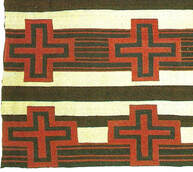
"The question is not so much "What do I learn from stories" as "What stories do I want to live?"
David R. Loy, "The World is Made of Stories"
As cultural anthropologist Carol Patterson-Rudolph eloquently wrote in her book On the Trail of Spider Woman - Petroglyphs, Pictographs, and Myths of the Southwest (1998) to the Navajo (Dine`) Grandmother Spider Woman ((NA ASHJE’II ’ASDZÁÁ) represents initiation into a mature, integrated way of being. Spider Woman thus is a bridge between the mundane, the mythic, and the sacred dimensions of life. Like a spider web, her transparent, circular strands exist on multiple levels of meaning. Spider Woman is revered by the Navajo because she taught them how to weave, a sacred art to them, as it is to the Pueblo peoples, that embodies important spiritual teachings. In Navajo rugs, “Spider Woman’s Cross” represents balance. To this day, a bit of spider web is rubbed into the palms of infant girls, so she will become a good weaver. Spider Woman is about initiation into wisdom - She is able to bridge the sacred and prosaic dimensions of life. But for those who are not ready, Grandmother Spider Woman will be invisible, appearing as nothing more than a tiny insect. And yet, for those with eyes to see, her Web is everywhere. The "Web" becomes visible within an integral, relational paradigm: a "webbed vision".
Spider Woman is ubiquitous throughout the Americas, found among the Maya, Pueblo and Navajo mythology, and among the pre-historic "Mound builders", the Mississippian cultures as well. There is evidence that the earliest Spider Woman was found among the Maya, where she is identified as the Earth Mother. I find this ancient myth a profound metaphor for our time, a symbol that can encompass ecology, community, theology, integral conciousness studies, and quantum physics.
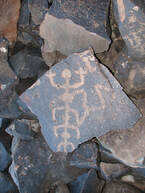
In his book on Hopi religion, anthropologist John Loftin writes that:
“Spider Woman was the first to weave. Her techniques and patterns have stood the test of time, or more properly, the test of timelessness – because they have always been present. It makes sense that one would follow the instructions of a deity who helped form the underlying structure of the world in which one lives...........Weaving is, from that perspective, not an act in which one creates something oneself – it is an act in which one uncovers a pattern that was already there.”
From her very being, the Spider spins silken, transparent threads that she organizes into the patterned symmetry of an ever-expanding Web. Tse Che Nako weaves, sharing this precious creative power with all of her Relations. With contemporary resonance, science now suggests that we live in a “thought universe” in which all forms of consciousness and living beings, as well as phenomena, are infinitely interconnected, interdependent, entangled, and responsive.
“Tse Che Nako, Thought-Woman, the Spider,
is sitting in her room thinking of a story now -
I'm telling you the story she is thinking. “
Keresan Pueblo proverb**
Among the pre-historic Mississippian culture many decorations and amulets have been found of a spider, with the solar or 4 directions cross on its back. Some are surrounded by a circle of hands. Another ubiquitous image is the Hand and Eye. While we cannot know the exact meanings of this prehistoric iconography, they speak to my imagination as metaphors for our time as well. Like the Spider Woman, we conceive with our minds. But we manifest the stories we tell about our lives, individually and collectively, with the works of our hands - Spider Woman’s hands are also our hands, all of us inter-dependant within the great ecology of the planet and each other. Spider Woman offers an opportunity to remember that we are co-creators with that which is ineffable and ultimately One.
A spiritual paradigm is founded upon mythic roots. Following the metaphor theologian Katherine Keller has provided: if we can find models that allow us to vision our world as it really is – a shimmering web of interconnected relationships – if we can see truly the world "with a webbed vision”…….then how, indeed, might we act?
Some Navajos still rub a bit of spider web into the hands of newborn female babies so the they will be blessed by Spider Woman and become good weavers. May we all "rub a bit of Spider Web" into the palms of our hands as well as we set to the tasks before us.
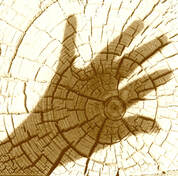
In 2007 I received an Alden Dow Fellowship at Northwood University to pursue “Spider Woman’s Hands” as a Community Art Project at the Midland Art Center. In 2008 the project was continued with the Creative Spirit Center and artist Kathy Space in Midland, Michigan. In 2009 "Weavers" was a continuation of the Project when I was resident artist at the Henry Luce Center for the Arts at Wesley Theological Seminary in Washington, D.C. I continue the weaving.
References:
Keller, Catherine Ph.D.: From a Broken Web: Separation, Sexism and Self (1989), Thames & Hudson
Loftin, John D.; Religion and Hopi Life, Second Edition, Indiana University Press, 2003
Loy, David: The World is Made of Stories, Wisdom Publications, 2010
Patterson-Rudolph, Carol: On the Trail of Spider Woman: Petroglyphs, Pictographs, and Myths of the Southwest, 1998, Ancient City Press (** quote from her book)
Spretnak, Charlene: The Politics of Women's Spirituality: Essays by Founding Mothers of the Movement, Edited by Charlene Spretnak, Anchor Books, 1982













